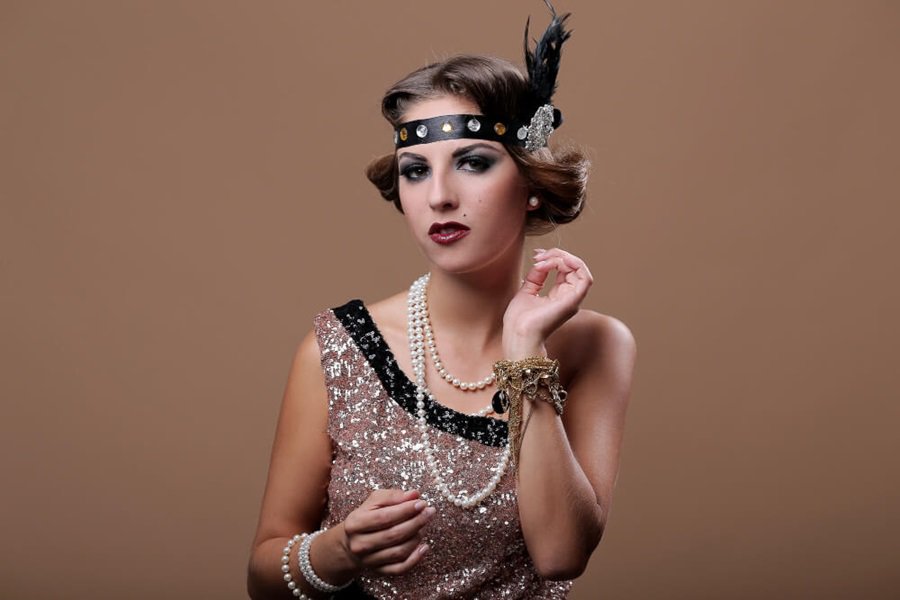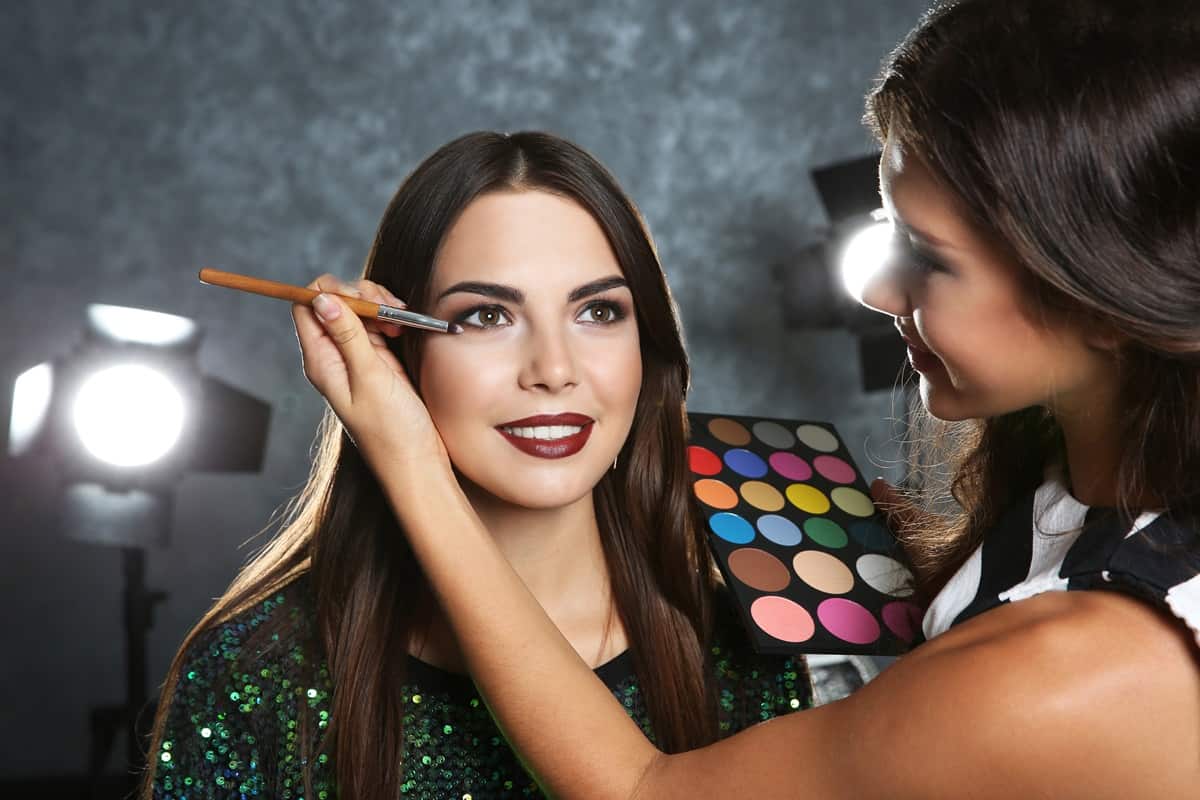1940s Makeup: How To Achieve The Perfect Look
6th February, 2024

Ah, yes – 1940s makeup, an era defined by luscious red lops, defined eyes, neat eyebrows and a charm that is just hard to match in modern times.
While that golden era from Hollywood which inspired many 1940s makeup looks decades later is gone, the “girl next door look” is something many women still obsess over.
Want to achieve the 1940s make-up look? Find out more now in this article.
How the 1940s influenced makeup and beauty as a whole
Wartime Rationing
Towards the start of the 1940s, nearly all of Europe was at war. With other nations joining the battle, wartime restrictions impacted everything from food to cosmetics. Everyday items started disappearing off the shelves one by one in a bid to fuel the war.
The wartime rationing affected literally everything: sugar, petrol, sausages, eggs nightshirts, etc. In fact, all the daily-use items that people had gotten accustomed to were now available only in a book of stamps, waiting to be claimed.
Alcohol soon fell short too, so that meant less perfumes and colognes. A reduced supply of fat and oils led to the rationing of soap. Glycerine was one of the key ingredients involved in the war effort, and once that was rationed, the cosmetics industry started to fall flat.
With metal and plastics also being redirected towards war rationing, packaging took a hit, which meant cosmetics could not be packaged and moved around effectively across Europe and the UK. Some cosmetics companies started making specific items to help with the war effort, leading to lower cosmetics production output. Revlon was one of them, making dye markers and first-aid kits for the American Navy.
Rationing within the UK made everyday items hard to get. Women, however, got creative with substitutes instead of outright giving up on makeup altogether! Some examples include:
- Beetroot juice or cochineal for lipstick
- Gravy browning to be used in place of stockings
- Burnt cork for mascara
- Bicarbonate of soda for deodorant
Second-hand theatre makeup soon started making rounds. Even after the war ended, rationing was still in place in Britain until 1954.
Explore Our Exclusive Makeup CollectionClick below to explore our curated collection and start your journey to a more glamorous you today! Find Professional Makeup |
Nailing the 1940s Make-up look: Your Ultimate Guide

The general premise of 1940s makeup looks was to look natural with a little bit of glamour added for good measure – so, that meant red lips, nails, and all that! Foundation was always a ‘natural’ affair where a rosy and subtle glow to the cheeks was preferred. Eyebrows of moderate thickness were shaped, brushed, and subtly filled in. Eyeshadow was just as subtle, matching the wearer’s natural eye colour, with a touch of mascara added to the lashes for a nice, finished look.
Achieving colour harmony with the various products was a very important skill to master. It was, in fact, the hair colour primarily which would help determine which colour range women wanted to go with. However, eye colour and skin tone also played important supporting roles.
If you go deep into the beauty guides revolving around 1940s makeup, you’ll find plenty of advice on colour-matching lips, cheek, and nails to a single coordinated shade.
While this sounds simple in theory, perfecting the 1940s makeup look was anything but, standing out in stark contrast to the 5-minute or so makeup routine that modern women follow.
1940s Make-up: Getting the Foundation Characteristics right
Foundations in the 1940s were very, very different compared to those of today. Back then, the shade range was much slimmer, for instance. Just look at the old ads from the era talking about 1940s makeup and you’ll see that nearly all talked about looking as natural as possible – no more than five shades, mind you!
Most foundations from the 1940s makeup look boasted a pinkish hue, something that worked remarkably well for the white women from that time, although not quite as well for people of colour. The latter would typically mix their own shades or just go makeup-free.
There were other distinctions as well compared to modern makeup practices, and not just those around the availability of different skin tones and shades. For example, the foundations in general were significantly creamier and thicker, which makes sense as lighter liquid foundations hadn’t been invented yet.
Face powder was a necessity in order to keep the face matte, and to match the underlying skin tone. However, foundation in the 1940s was used for more than just evening out the skin colour – it helped keep the powder intact within the facial pores – had it not been for this, the powders would just fall off!
Foundation and powder typically extended below the neckline to conceal any skin tone inconsistencies.
If you’re looking for no tattoos in the look but have them obstructing your goal, we recommend using tattoo cover up makeup to achieve your desired look.
1940s Makeup Look: The Powder
Powders played a rather significant role in 1940s makeup, providing a nice matte look to the face because the foundations looked heavy and glossy. The matte look helped to blend the foundation with the face’s natural skin tone as best as possible.
Light shades were the norm, keeping the skin looking fresh, jubilant, and youthful. A mild bronze shade was often used to add a sun kissed glow, something made very popular by film stars of the 1940s and 1950s – hello, Linda Darnell! This is why you might have seen many actresses from 1950s Hollywood with makeup lines which carried a sun kissed colour.
Is your skin exhibiting a yellowish hue? A pinker tone will work brilliantly to brighten and lift your face. A puff was commonly used in the 1940s to allow for a liberal application of powder to the face. This would then be effortlessly brushed off with a medium-large brush, starting from the neck and ending at the forehead. Looking for makeup brush ideas? This has just what you need!
It’s best to use the brush in a downward motion only once so give the skin a smooth and seamless finish without any fuzz.
1940s Make-up: Blush or Rouge?
At the time, blushes or rouge, as they were known, were used sparingly, and just like foundation, didn’t have too many shades to boast about! They were typically available in pinkish shades, ranging from peach to coral tones (pale skin) and raspberry tones (bronzed skin).
Rouge cream formulations were mostly used to give off a very natural tone and would be blended in with the foundation. Additionally, compressed powder foundations would be gently brushed on the cheekbones to achieve the highly sought-after natural and rosy-cheeked look.
1940s Makeup Look: The Eyebrows
Thin and arched eyebrows continued to be carried over from the 1930s, right up until the early 1940s, and that’s what gave birth to the lovely contoured faces dating back to this decade! Most women preferred to wear their eyebrows naturally with just the stray hairs plucked to create a very neat and even look, complete with the signature arch that was synonymous with the 1940s’ woman.
Eyebrow pencils which were a few shades darker than the hair proved useful for defining the eyebrows, where women would draw a line right at the top of their brow, while leaving the underside soft. However, most women preferred not to use an eyebrow pencil on a daily basis. All they needed was a quick dab of some petroleum jelly to ‘gel’ the eyebrow hair into a nice arch.
This came to be known as the “dove wing” as it look strikingly similar to a dove flapping its wing while flying!
1940s makeup looks for the eye
Hardly any makeup was used around the eyes in the 1940s. Why? The key focus, unsurprisingly, were the lips, of course!
So, for the eyes, most women liked to wear a dull dark brown or black mascara while out in the day, along with the usual petroleum jelly/Vaseline to give the lashes a dark and dramatic appearance.
Mascara at the time was available either in cake, liquid, or paste form, complete with a little brush for seamless application. A tiny drop of water or some spit would typically be added to the cake form to create that thick buildup. Compared to the lashes of today, 1940s lashes were a lot heavier, as a result. Mascara was typically applied to both the upper and lower lashes.
Eyeshadow for 1940s makeup
While eyeshadow used to be worn back then, they were typically worn in neutral colours mostly and usually on evenings out only. Women would match the eyeshadow with their eye colour, and not complement it, which is in stark contrast with the makeup norms of today.
Blue-eyed women would apply blue-grey eyeshadow while those with black, brown or hazel eyes would apply brown eyeshadow. Green-eyed women would use grey eyeshadow, and so on.
When women wore eyeshadow in the evening, they would often match it with their dress although silver and gold became two very popular kinds of ‘everyday shade’, eventually.
Additionally, eyeshadow used to be worn in only one eye, running from the lashline to the brow, blended perfectly for stunning, head-turning evening looks. For daywear, eyeshadow would be worn on the top eyelid.
It wasn’t until the end of 1940s that eyeliner became a thing, but even then it was to be used to adorn the top lashline only. Most women thought that eyeliner gave off an unnatural or fake look to begin with.
1940s make-up for the lips
Now, the most important part of the 1940s makeup look was, of course, the lips.
Lipstick was seen by women as a mood elevator during the war, giving them a spark of hope. Luckily, lipstick wasn’t under war rationing, so red became the fashionable choice although other tones were available such as bluish and orangish ones.
Red, however, became a staple for lipstick colour – during fall, women would wear darker shades of red and in spring, they would wear lighter ones. The 1950s saw the introduction of bright pink shades of lipstick.
Fingernails for 1940s makeup looks
Nail polish would typically be matched to the lipstick’s colour, although one very popular fingernail style between the 1920s and 1940s was to draw the polish or colour in a half moon shape, leaving the other half unpainted.
Mesmerising 1940s Era That Stands The Test Of Time
Hopefully, you lovely ladies enjoyed this read on 1940s makeup ideas. What a mesmerising era, with such stunning performances on screen. The makeup had a large part in it, and now you too can look the part of a 1940s Hollywood queen! Find out more by learning about old hollywood glamour makeup today as well as other makeup tips on our blog.
FAQs
What makeup was popular in the 1940s?
What were the ingredients in makeup in the 1940s?
Sources
Escobar, S., (2016) 4 Ways to Recreate Classic Hollywood Makeup Looks. Good Housekeeping. [online] available at: https://www.goodhousekeeping.com/beauty/makeup/g3088/old-hollywood-glamour-makeup/
Hey there! I’m Isabelle Kerrington, and I’m thrilled to share my passion for the performing arts through my blog. Focusing on theatre makeup, my posts will cover everything from product recommendations to helpful tips and engaging tutorials. Join me on this exciting journey as we explore the magical world of theatre makeup together.
Leave a Reply